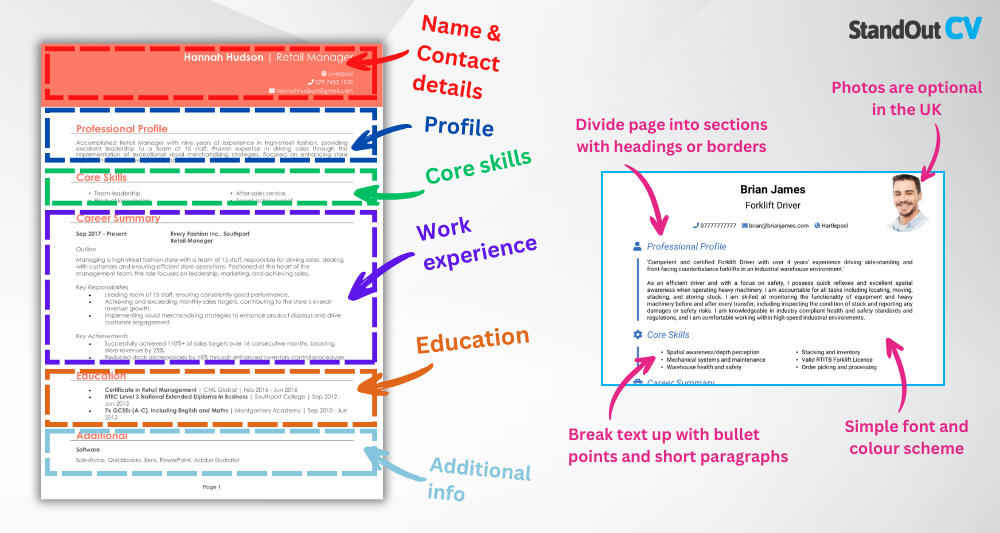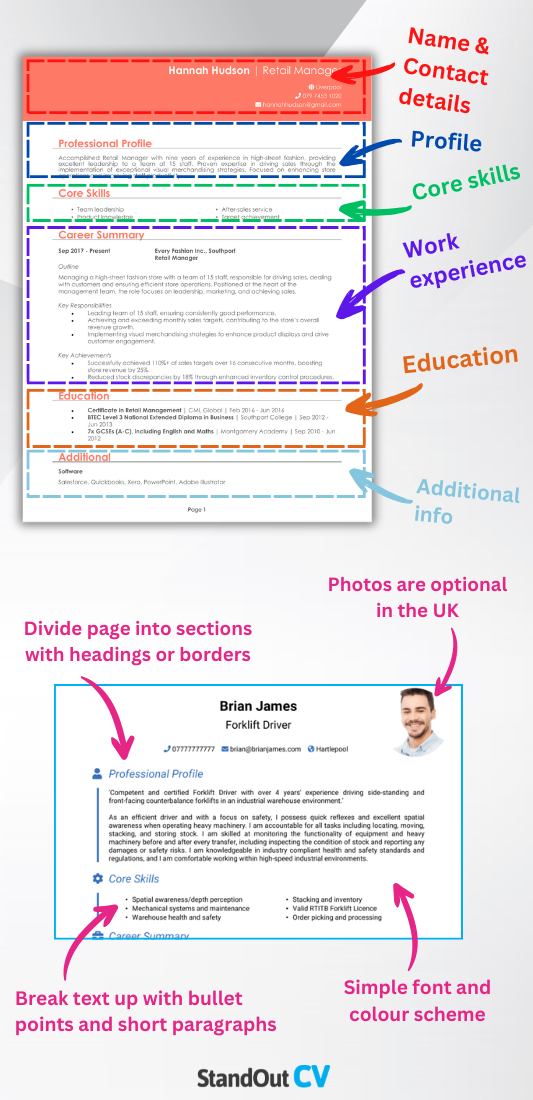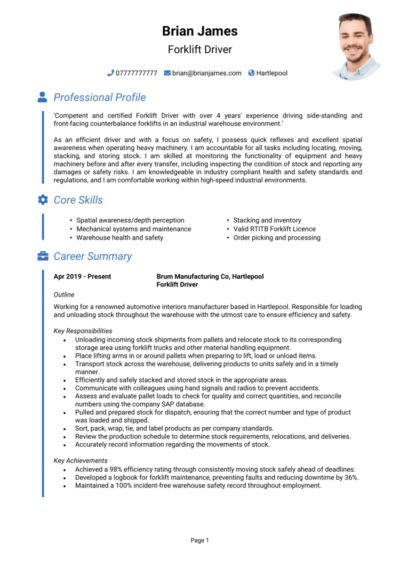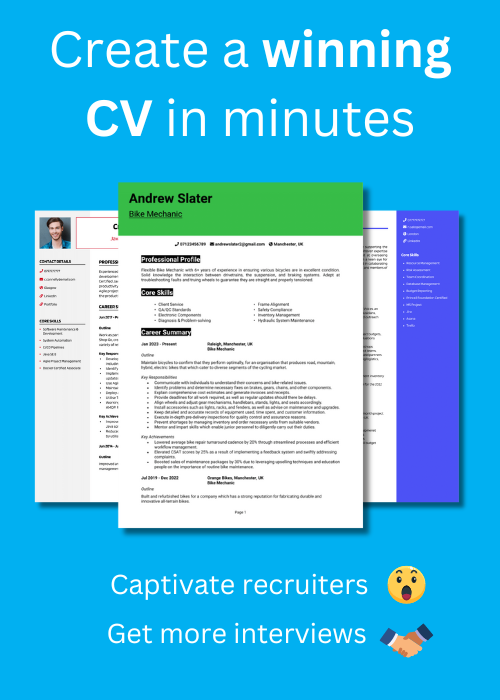Operating a forklift is a rewarding and secure role. As a result, the roles can be competitive.
If you want employers to trust you behind the controls, your CV needs to reflect that reliability from the first glance. This guide, with a Forklift Driver CV example and tailored advice, will help you put together a CV that lifts potential as well as pallets.
Forklift Driver CV sample

How to write your Forklift Driver CV
Discover how to craft a winning Forklift Driver CV that lands interviews with this simple step-by-step guide.
Recruiters need more than proof of your licence – they want to know that you’re dependable, efficient, and know how to keep things running safely on the warehouse floor.
This guide walks you through writing a CV, from structure and formatting to writing a powerful profile and describing your experience clearly. You’ll learn how to present your background in a way that lifts you above the rest.
Structuring and formatting your Forklift Driver CV


If your CV’s all over the place, it doesn’t matter how organised you are in the warehouse – recruiters won’t wait around to figure it out. A clear CV structure shows you take clarity and consistency seriously – just like you would with any piece of heavy machinery. Your sections should effortlessly guide a reader through what makes you the right candidate.
Here’s the layout to follow:
- Name and contact details – Ensure your name and personal details are easily visible at the top. A photo is optional and depends on the role.
- Profile – Craft a short introduction that showcases your professional background and key accomplishments.
- Core skills – Provide a quick overview of your top skills that show why you’re a great fit.
- Work experience – Outline your career progression in reverse order, emphasising your contributions and successes.
- Education – Provide details on your academic background, including certifications or specialised training.
- Additional info – You can add hobbies or activities here that reflect your enthusiasm for the industry.
To make sure your CV is easy to scan, use bold section headings to format and separate the above sections. Break up the text within each using bullet points for clarity. Keep the document’s length to two pages max, use a clean and readable font, and make sure your formatting is consistent from top to bottom. Following these tips will show you know how to get the job done right.
The best way to write a Forklift Driver CV profile


This opening paragraph is your first chance to show that you’re more than just a licence-holder – you’re someone who can be trusted with equipment, meet tight deadlines, and work as part of a team.
Your CV profile should clearly summarise the types of forklifts you’re trained to operate, your experience across different working environments, and any additional certifications or safety credentials you hold. It should also give a sense of your working style, and how that’d benefit any company which hires you.
Forklift Driver CV profile examples
Profile 1
Reliable Forklift Driver with over 10 years of experience operating counterbalance and reach trucks in busy warehouse and distribution centre environments. Skilled in loading, unloading, and stock rotation with a strong focus on health and safety compliance. Holds a valid RTITB licence and consistently meets productivity targets.
Profile 2
Experienced Forklift Operator with seven years of experience working across logistics, construction, and manufacturing sectors. Proficient in safely moving goods, conducting pre-use equipment checks, and maintaining accurate stock movement records. Known for working efficiently in fast-paced and physically demanding settings.
Profile 3
Hardworking Forklift Driver with five years of experience supporting inventory and shipping operations in large-scale storage facilities. Comfortable using handheld scanners, following pick sheets, and ensuring safe stacking and racking of pallets. Holds a full clean driving licence and up-to-date forklift certification.
Details to put in your Forklift Driver CV profile
To write a profile that gets you moving, include:
- Where you worked – Warehouses, construction sites, manufacturing plants, distribution centres
- Your top qualifications – RTITB or ITSSAR forklift certifications, safety courses, manual handling training
- Essential skills – Loading/unloading, pallet stacking, stock rotation, working from pick lists
- Types of forklifts used – Counterbalance, reach truck, telehandler, side loader, or VNA
- Working environments – Cold storage, night shifts, multi-lingual teams, or high-turnover logistics
How to present your core skills section properly


This short list should outline your strongest forklift-related abilities. Ideally, you should cover the keywords which recruiters are looking for when they open up a CV – so take a look at the job spec for some inspiration.
Stick to the actual CV skills they want to see in the workplace, avoiding soft skills like “hardworking” or “reliable”.
Key skills that make a Forklift Driver CV stand out
- Forklift Operation – Safely operating forklifts to load, unload, and transport materials in warehouses, factories, or distribution centres.
- Pallet Stacking and Racking – Placing goods securely onto racking systems and organising stock to maximise space and efficiency.
- Load Handling and Weight Distribution – Assessing loads for stability and ensuring safe lifting within forklift weight limits.
- Warehouse Navigation and Safety – Manoeuvring through tight spaces and high-traffic areas while adhering to site safety rules.
- Inventory Movement and Tracking – Moving stock to designated areas and updating inventory systems to maintain accurate records.
- Pre-Operation Safety Checks – Inspecting forklift components such as brakes, lights, and forks before each use to ensure safe operation.
- Order Picking and Packing Support – Assisting with fulfilling orders by retrieving items and preparing them for dispatch.
- Vehicle and Equipment Maintenance – Reporting faults and performing minor upkeep to keep machinery in proper working condition.
- Loading Bay and Dock Work – Coordinating with delivery drivers to load and unload lorries safely and efficiently.
- Licensing and Regulation Compliance – Holding valid forklift certification and following industry health and safety standards.
How to present your work experience in your CV


Your work experience section is the most important part of your CV – this is where you show how well you’ve handled your past responsibilities.
List your roles in reverse chronological order, starting with the most recent. For each position, write a short summary of your job and the site or employer, followed by bullet points outlining what you did and what you achieved. Mention any specific achievements, ideally backed up with figures.
And if you’ve worked in other warehouse roles before becoming a forklift driver, include those – they show your wider knowledge of stock handling, teamwork, and logistics.
How should you list jobs on your Forklift Driver CV?

- Outline – Briefly introduce the employer, type of site (e.g. warehouse, depot, construction), and what your role involved day-to-day.
- Responsibilities – Use action words like “operated” and “transported.” For example: “operated reach and counterbalance trucks to transport stock across multiple warehouse zones” or “transported goods between loading bays and production areas in a fast-paced distribution centre.” Mention H&S procedures and team coordination too.
- Achievements – Include anything that shows your impact: reduction in damage rates, zero safety incidents, improved delivery turnaround, or praise from supervisors. Quantify where possible.
Work history examples for Forklift Drivers
Forklift Driver | Trentgrove Logistisc
Outline
Worked in a high-volume regional distribution centre for a third-party logistics provider, moving goods and assisting with daily warehouse operations.
Responsibilities
- Operated counterbalance forklifts to load and unload delivery vehicles
- Moved stock between loading bays and storage zones using reach trucks
- Completed pre-shift equipment checks and reported any faults or issues
- Followed site health and safety procedures including proper stacking methods
- Used barcode scanners to track pallet locations and support inventory accuracy
Achievements
- Maintained a 100% accident-free record over three years of service
- Recognised for consistent order accuracy during peak delivery seasons
- Assisted with mentoring two new forklift operators during onboarding
Forklift Driver | Newton Materials Ltd
Outline
Provided forklift support for a construction materials supplier, working in the yard and warehouse to load stock for contractors and organise inbound deliveries.
Responsibilities
- Used forklifts to move pallets of bricks, plasterboard, and cement safely
- Loaded flatbed trucks for customer deliveries and contractor pickups
- Supported stock counts and organised materials by weight and delivery schedules
- Worked closely with warehouse and transport teams to meet dispatch deadlines
- Kept work areas clear of hazards and followed PPE and manual handling protocols
Achievements
- Reduced product damage by 20% through improved loading procedures
- Commended for speed and accuracy during monthly team performance reviews
- Helped reduce loading bay congestion by improving traffic flow layout
Forklift Driver | Brightside Manufacturing Co.
Outline
Supported warehouse operations in a fast-paced factory environment, ensuring timely movement of raw materials and finished goods between production lines and storage.
Responsibilities
- Transported goods using counterbalance and side-loader forklifts across site
- Supplied production lines with raw materials as per hourly shift requirements
- Removed completed goods for packing and dispatch teams
- Logged goods movements using handheld devices and paper checklists
- Maintained clean work areas and followed strict HSE and traffic management rules
Achievements
- Helped improve line efficiency by reducing delivery delays during shift handovers
- Contributed to warehouse layout redesign that increased space efficiency by 25%
- Maintained perfect attendance record across 18 months of shift work
Presenting your education history


Your education section should highlight any academic background or training that supports your role – especially anything safety-related or logistics-focused. This could include school qualifications, vocational certificates, or short training courses.
Start with your most recent qualifications and work backwards. If you’ve taken forklift certification through RTITB, ITSSAR, or another body, this is the place to mention it – along with any refresher or advanced training you’ve completed. Also include relevant workplace training in health and safety.
Best qualifications for a Forklift Driver
- RTITB Forklift Truck Certification – Nationally recognised training for counterbalance, reach, or telehandler forklifts
- ITSSAR Operator Training Certificate – Validates safe and efficient forklift operation across multiple types
- Level 2 Certificate in Warehousing and Storage – Useful for understanding stock handling, safety, and logistics
- Manual Handling Awareness Certificate – Demonstrates knowledge of proper lifting and handling procedures
- Level 1 Health and Safety in the Workplace – Ideal for demonstrating awareness of essential site protocols





